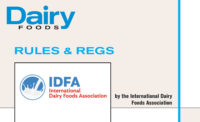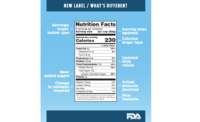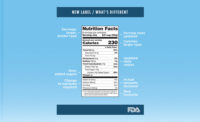Consumers walking down the dairy aisle have their choice of many different brands and products, from traditional favorites to new offerings with novel tastes, textures, flavors and nutritional content. When they’re making purchase decisions, product labels matter.
For dairy foods processors seeking to innovate and meet consumer demands, product labels matter, too, because FDA has strict standards of identity that companies must meet before placing a “milk,” “cheese” or “yogurt” label on a product. FDA also decides what appears on nutrition and ingredients labels, as well as whether a product can include claims such as “healthy.” Overall, dairy product regulations represent one-third of the 280 federal food standards of identity.
FDA’s standards, however, have not kept pace with the industry’s desire to use new technologies and ingredients to meet consumer cravings, and the current system of petitioning and rulemaking for revising standards is not working. Requests to modernize yogurt standards, for example, have been pending for 16 years.
That’s why dairy companies welcomed FDA’s announcement in March that it would tackle food standards modernization and product labeling as part of its Comprehensive Multi-Year Nutrition Innovation Strategy. With FDA offering several opportunities for public comment and meetings, the International Dairy Foods Association (IDFA) is calling for an ambitious approach not only
in modernizing standards and labeling, but also in changing the agency’s methods for modernization in the future.
IDFA proposes a horizontal approach that would update specific categories across all food standards instead of updating individual food standards. FDA would have the flexibility to allow novel formulations such as filtered milks as an approved ingredient for cheese and other dairy products without revising individual standards of identity. The horizontal approach would also help FDA address resource constraints by minimizing the need for notice-and-comment rulemaking proceedings for each standard of identity. With more timely updates, the dairy industry could better innovate and respond to consumer demands.
‘Healthy’ claims and clean labels
Developing a “healthy” icon for labels also is on FDA’s radar, but updates to the agency’s regulation outlining the proper use of “healthy” claims on labels has yet to be finalized. IDFA encourages FDA to complete these updates before considering the use of an icon to avoid consumer confusion. Product labels today carry many symbols and claims, and IDFA believes consumers must understand what a “healthy” icon means so they won’t confuse it with other symbols.
With the consumer’s desire for clean labels that are less complex and easy to understand, FDA also is revisiting ingredient labeling. IDFA supports FDA’s efforts to simplify ingredient labels to allow consumer-friendly terms instead of scientific names — for example, allowing cheeses that use potassium chloride as a salt substitute to list it as “potassium salt.”
For the dairy industry, FDA’s special request for information on using traditional dairy foods names in the labeling of plant-based products will yield much-needed clarification. The agency is interested in learning how consumers use plant-based products in their daily diets, as well as how they understand terms such as “milk,” “yogurt” or “cheese” when products are made with soy, peas or nuts.
FDA also seeks to determine if consumers understand the differences in characteristics, ingredients and nutritional content between dairy and plant-based products that use the same terms. IDFA welcomes this first step by FDA to gather research and comments to guide its policy decisions and provide more clarity on the labeling of plant-based foods and beverages.
With the right approach and focus, FDA’s comprehensive initiative will provide the updates companies need to innovate and meet the increasingly creative tastes of today’s consumers.





